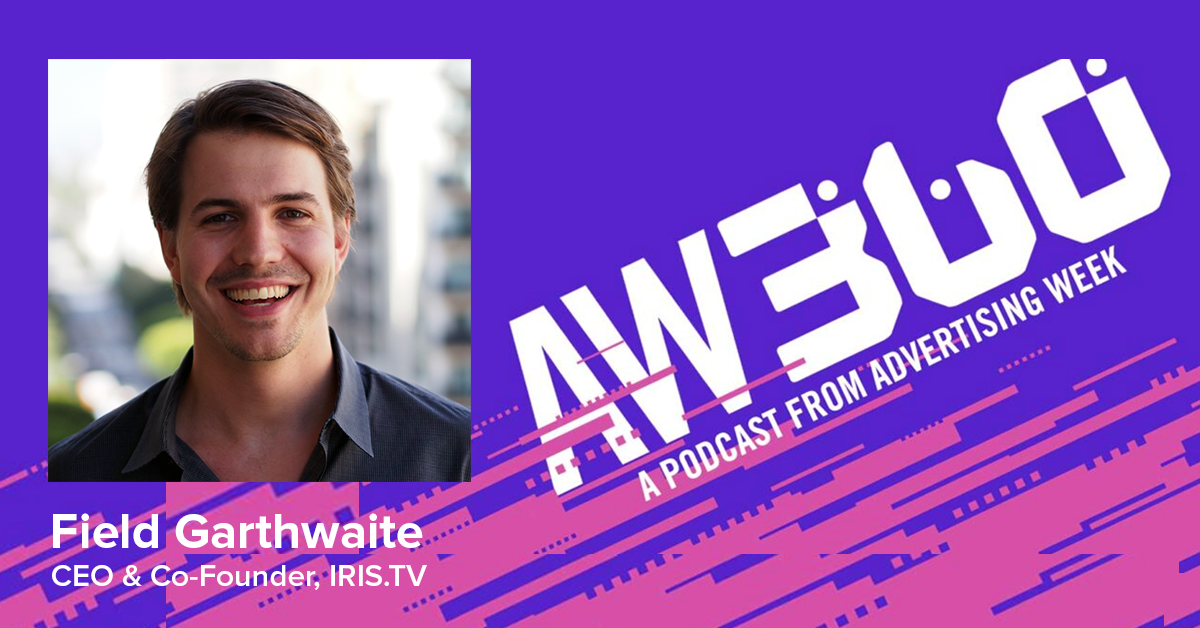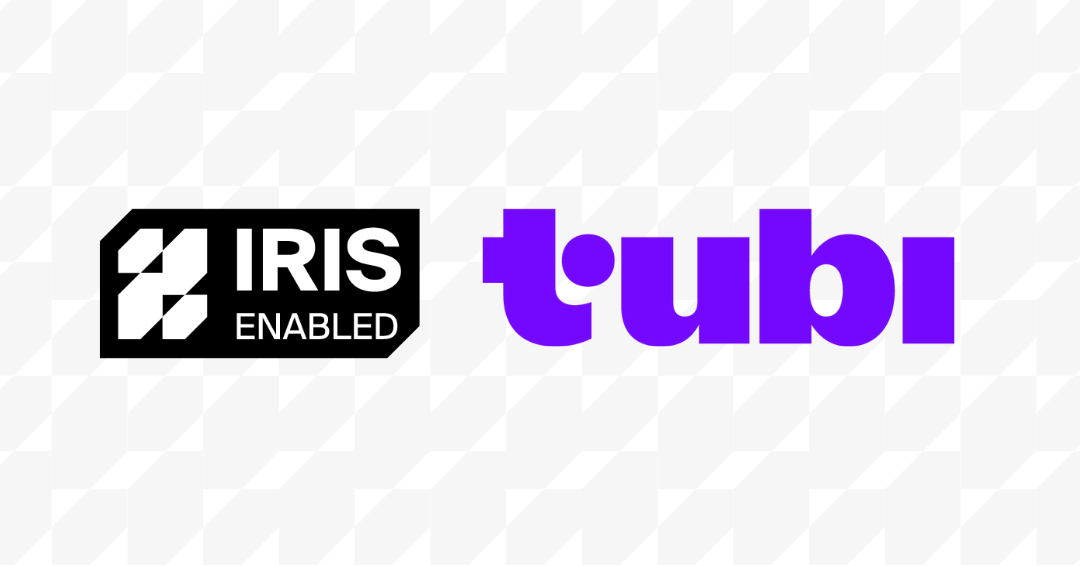Podcast: AW360 - IRIS.TV Brings Content-Level Transparency to CTV Advertising
Posted by Rohan Castelino | Dec 13, 2021 | Contextual Video,Video |
On this episode of the AW360 podcast we’re speaking with Field Garthwaite, Co-Founder and CEO of IRIS TV. IRIS TV is in the business of making television advertising, specifically connected television advertising better, more transparent, and effective for advertisers.
AW360:
Thank you for listening to the AW360 Podcast. Today on the show, I'm speaking with Field Garthwaite, co-founder and CEO of IRIS.TV. IRIS.TV is in the business of making television advertising, specifically connected television advertising, better, more transparent, and more effective for advertisers. I hope you enjoy this episode. Field Garthwaite, welcome to the AW360 Podcast. Pleased to have you here today.
Field Garthwaite, CEO & Co-Founder, IRIS.TV:
Thanks for having me.
AW360: So you are co-founder and CEO of IRIS.TV. For the uninitiated, tell us a little bit about IRIS and what you guys do.
FG: We've all had that experience wondering why we see ads that are completely irrelevant to us, and this has become increasingly common during the pandemic, right? We're all watching connected TV and more and more of that is becoming ad-supported.
That's actually the fastest growing media format in the US, it's growing 50% year-over-year. And there's so much new content available, but it hasn't been possible to keep track of it all. Advertisers don't actually know where their ads run against, and this is creating major problems, both for consumers and having a bad user experience, but as an actual marketer, and ad agencies, and ad DSPs and SSPs, targeting and managing frequency is something that they have real problems with.
Managing transparency and driving repeatable performance when working with all of the great content owners that we all know and love, it's been really challenging. And so the kind of problem that IRIS.TV has been focused on is really providing video-level data access to everyone, buyers and sellers. And the reason is because who you're targeting and what they're watching really are equally important.
At IRIS.TV, we built a video data platform specifically to connect TV shows, movies, and videos with all of the leading data partners that manage brand safety, and suitability, and contextual data. We're trusted by the largest broadcasters, and now thousands of publishers and CTV channels, to help them securely manage the data, their most valuable content, and convert those video files into data that brands and advertisers can use at a really large scale for brand safety, transparency, and things like contextual targeting that make ads more relevant to the end viewer, and as a result, drive things like recall and sales lift.
AW360: This is actually a persistent complaint of mine around my household. That, with all of these vast stores of data, every time I turn on any sort of streaming channel, I'm constantly frustrated that my TV doesn't get me. Like it either thinks I'm somebody else entirely, or it's completely missing the point of me and my life. Explain a little bit about how your solution works.
FG: Okay, well, yeah, and what you just said, every brand wants to reach consumers at the right time with their marketing, but, yeah, it hasn't been possible in video. The way that IRIS.TV does this is through the IRIS ID which is a universal identifier for video content. There's an IRS ID for every TV show, every video, every movie. And that content identifier is basically like the video equivalent of a page URL, which is a technology that AdWords uses to understand how to target ads, and all of the leading brand safety and contextual data companies used to use for display ads, but it's not sufficient for video.
By having the IRIS ID associated with each video file, we're able to store an enormous amount of data including contextual data, brand safety data, from companies like Oracle Advertising and GumGum, and over a dozen of our partners in the data space.
Most importantly, the way that this works is that content owners actually have control over the IRIS ID and how it's used, so they can actually decide who gets access to what data. So it's a very valuable technology for them to basically manage who gets access to certain information. They want ad platforms to use it to target based on context or brand safety and increase the value of their inventory so it's helping to increase yield and increase revenue. But, in some cases, like reporting, they may want other entities to have access to show and episode-level data. And we allow them to manage all of those use cases with the IRIS ID framework.
AW360: During COVID, obviously, streaming TV and CTV skyrocketed. I mean, there was so much consumption that I've heard various complaints from friends and colleagues that, "The internet in my neighborhood is now so slow."
And it's because everybody's trying to watch whatever show on Netflix, or what have you, all at the same time. But yet it seems like, and I've read this a few different places now, that advertising dollars have not necessarily followed that trend, why is that? And how is what you're doing at IRIS.TV going to kind of shift that back to more of a balance?
FG: We hear this from every major agency and all the largest marketers that spend huge amounts of money on television that they know they need to move more of their TV investment into connected TV and premium online video. The major blockers for them have been that they can't replicate dayparts in connected TV or by what we used to call primetime. That kind of block of time where you knew you'd hit a massive audience and you'd be able to actually understand by points, essentially, what the demographics were and kind of then able to measure how effective it was. There's been no content transparency in CTV. It's really taken off in terms of streaming and viewership without having the same level of transparency that TV buyers, and broadcasters, and MVPDs have had for decades.
When you have transparency it unlocks more advertising dollars and creates a better user experience. You can actually start to replicate things like primetime by knowing, for example, that Verizon can reach viewers watching sports, or college football, or pro basketball, at the exact moment that they're watching that content. Or Intel can target viewers watching tech or video games. Mountain Dew can reach viewers watching comedy at that exact moment. And it drives performance when you're able to do that, and this is a brand new technology. It's really only come into a kind of real scale over the last year.
Our business has been taking off as a result of enabling this capability. And a major part of this is preparing for kind of the next years up-front and really '22 budgets that are beginning to kind of unify TV investment and connected TV as really kind of like a holistic plan.
AW360: It kind of goes without saying that transparency has been one of the big buzzwords in our industry for the past several years. How does transparency work in regard to the IRIS ID? Do you have concerns there? Or is it pretty much in step with what the expectation is these days as far as consumers are concerned?
FG: There's identity and then there's content. Those are the two major parameters when you're talking about taking a piece of ad creative and reaching the right audience at a really large scale. And IPG just completed a research study with our partner at GumGum, and the conclusion was pretty simple, it's always important to reach the right people, but the powerhouse behind contextual, which is really GumGums's core focus, is reaching people in the relevant mindset and that's really what drives results. What they were able to prove is that it increases search intent, increases brand favorability, things like recall and search. And it's pretty simple to kind of understand why.
If you think about Google and AdWords, it's a $50 billion business, it's really big. And it's because a consumer searches for something, and then instantly gets relevant results that are targeted ads, inclusive, also search results, relevant to their direct experience in that moment, and that's really what IRIS.TV is doing.
We're unlocking all of this data that's been embedded in the video file. We're making it available in standardized formats, working with all of our third-party data partners. And that really solves for the kind of content targeting side of things and this complements identity.
So things like household identifiers have become kind of the norm for how you buy identity in CTV. That's great because you can capture a bunch of useful signals to understand that you're reaching the right household. But if you have five people in a household, you're gonna waste a huge amount of that budget if you don't actually have the ability to guarantee contextual alignment of your ad, because those different viewers will be watching different types of content, and there's gonna be ads may be targeting your daughter, or your wife, or your husband, that you're seeing. And that's all gonna come down to what content is being viewed to really guarantee that the marketer and advertiser is getting the results that they expect from things like television.
AW360: So looking ahead to 2022, am I personally going to see fewer ads for all the various medications and prescriptions that I absolutely do not need yet in this point in my life? And I'm constantly bombarded with them. Or is that a symptom of the programming I'm watching, which really, when it comes right down to it, is 50% live sports?
FG: The answer is, yes, absolutely. And every marketer is going to be happy about that. Every agency is gonna be happy about that. It actually benefits the broadcaster too because if they're able to actually match the right ads with the right content, they're able to drive better results.
When it comes to TV, it's all about recall and things like sales lift done through brand lift studies, and with connected TV, that's all relatively new. But what we're also seeing, and this really benefits publishers, is that there's a ton of new buyers moving into connected TV. Direct-to-consumer brands are spending huge amounts of money in search and social, and now are seeing connected TV as a medium kind of like direct response television advertising where we used to see the phone number and people would call and purchase the product. We're seeing those types of direct-to-consumer products use connected TV in a targeted way, leveraging identity and context to drive performance and actual sales and they're able to measure that. That creates a new pocket of buyers that publishers can derive more value from their content libraries anytime they match that correctly.
AW360: And looking ahead, conscious of the fact that we're almost at the end of 2021 and moving into 2022 and beyond, what sort of predictions do you have for the next year, or even five years down the road, as it relates to the CTV industry and IRIS.TV's place in it?
FG: Well, I think one big one is there's kind of a sea change happening in market right now that I think the closest comparison would be viewability. If you remember when viewability first happened, it was kind of a scary moment for agencies. Because they needed to then actually look at how they were wasting a lot of money on ads that weren't viewable. Or kind of as we think about it on web or mobile, like below the fold, right? They're not viewed in-frame and so you actually don't know what you're getting. There's a comparable moment here happening in connected TV.
First, it started with things like fraud, and bot farms, and looking at for invalid traffic. That problem is being solved now by great companies like DoubleVerify and IAS. But really when it comes down to actual content transparency, things like brand safety and suitability, that problem has not been solved. It's looking like the early days of display where you have huge amounts of growth, tons of new supply sources, and a lot of premium viewership, but there's so little transparency available to buyers that they haven't been able to securely shift dollars. What's going to start happening is when I see this move from basically publisher, or app, or channel-level buying, where you might be getting data on Roku, or data on something like Samsung, but none of the information about the hundreds of channels or thousands of apps of where your ad could be placed back, where you actually have data on the ad pod level. That benefits everyone in the supply chain, because when you're buying at the app level you have no transparency, you're basically guessing. Relevance and performance really happens at the moment that the ad is playing. To do that, you really need to look inside the video.
So our major prediction is that this technology is going to be adopted widely, buyers are going to be requesting it and looking for IRIS-enabled™ video because it allows them to do so much more with every buy, and broadcasters, publishers, CTV apps are going to leverage it to increase yield. In both cases, everyone benefits, and that's been proven by Nielsen in the television space. They've shown that sales and recall can increase by 30% when you match ad creative with the moment that you're running relevant content. So it's really just, and from our point of view, all about scaling that technology everywhere, AVOD viewership is growing.
AW360: A tip of the hat to you. Normally, when I ask you a question like that I get sort of a hesitant best guess, and this felt more like a roadmap. Like, "Hey, we're not only on it, we've foreseen it." And I could have said 10 or 20 years and you would've had a great answer. So I appreciated that. This has been great, thanks so much for joining me on the show today.
FG: Great being here.
AW360: Thanks for listening. For more content from Advertising Week, the global leader in events and digital content for the advertising, marketing, and technology industries, visit www.advertisingweek.com.




.png)

.png)



